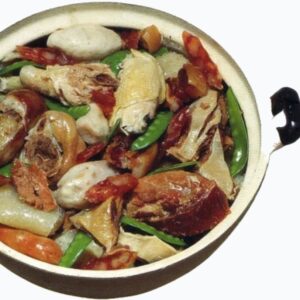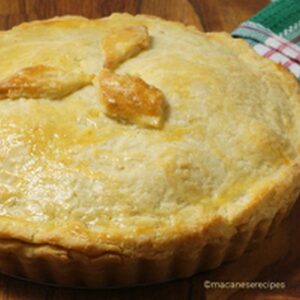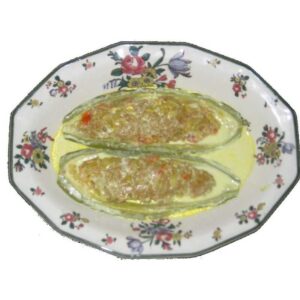ABOUT MACANESE CUISINE
Macanese cuisine blended, in a unique fashion, ingredients and flavours from Portuguese settlements and trading-posts spanning half the globe – from Brazil, Mozambique, Goa and Malacca, of course from Portugal and China – and with traces from as far as Japan. We find hot chillies from Brazil, curries from India, coconut and strong shrimp flavours from Malaysia, the wide variety of dishes from China, and from the Mediterranean bacalhau (salted cod), olive oil and bay leaves. This is one of the oldest and arguably the most diverse fusion cuisines in the world.
The traffic has been not been just one-way: the famous Chinese tahn taht (egg custard tartlets), available today in all Chinatowns, is derived from the Portuguese pasteis de nata and there is evidence that the Japanese tempura originated from the food eaten by Portuguese missionaries during times of fasting. The Macanese miço Cristam, a paste made from soy beans, appears similar to the Japanese miso.
The staple for every table was and is minchi, made with mince meat (beef, pork, veal or chicken, and often a combination of two of these). Every mother had her own recipe. The “standard” version used soy sauce (typically, both light and dark), and was garnished with crunchy, deep-fried diced potato, but there were many variations that use turmeric powder instead of soy sauce, add bitter melon or black fungus, and so on.
The key ingredient in many dishes was balichão (pronounced, in the Macanese patois, “balichung“ ) which was a derivative of the Malay blachan or the Chinese shrimp paste hahm har cheong – but, in this writer’s humble opinion, balichão is more delicate, subtly flavoursome and infinitely preferable. It was made from krill (a crustacean resembling a tiny shrimp) mixed with bay leaves, chillies, whole cloves, lime, peppercorns and laced with fortified wine. Today it is virtually unobtainable in original form, but a passable copy can be made from Philippine bagoong alamang, jars of which can be purchased from Asian grocers. So central was balichão to their cuisine that Macanese called themselves balichung. (They also called themselves, Nossa Gente (our folk),and in patois, filo-Macau/filho-Macau, from filhos de Macau – children of Macau – and Maquista/Macaísta.)
The dish tacho (also called chau chau de pele) probably evolved from the Portuguese cozido, a stew of meats and vegetables having much in common with the French pot-au-feu and New England hotpot, but tacho uses Chinese sausages instead of the Portuguese chouriço and pele (in Cantonese, kohn chee pei – dried pork skin) which vaguely resembles unsalted pork crackling (but which unfortunately is unobtainable in some countries because of quarantine laws).

Tacho (Mixed meats and vegetables
A dish unlike any other is porco balichão tamarindo or tamarinho – pork with balichão, made tart with tamarind and sweetened slightly with jagra (in Cantonese wong pin tong – slabs of brown cane sugar probably named after the Indian jaggery).
The Portuguese are renowned for their sweets, many of them lavish in their use of eggs, and variations appear in many Macanese cakes and desserts. An interesting group was served at Christmas time: bolo menino (Christ-child cake), alua (a sweet block made from grated coconut, jagra, almonds and pine-nuts), coscorão (thin strips of pastry, deep-fried and sprinkled with icing sugar, a close relative of the Italian sweet) and farte (a small pastry filled with pine-nuts, almonds and grated coconut), representing respectively the mattress, sheets and pillow of the bed of the baby Jesus.
A unique fusion dish, also served in yuletide, is empada (a pie with shortbread crust rich with egg yolks, lard and pine-nuts and filled with the unlikely combination of fish curry, olives, cheese and boiled eggs).
The list is endless. Fortunately there are available a number of well-illustrated recipe books, in English and in Portuguese, and periodically the various Macanese clubs around the world publish recipes.

J. Bosco Correa points out that the famous Goan vindaloo curry is based on the Portuguese dish carne de vinho e alho (meat marinated in wine and garlic), and that the Portuguese introduced it, together with chillies and vinegar, into India. The Goans added exotic spices, and thus was born vindaloo (Goan pidgin for vinho d’alho). He adds:
“My late and dear friend António Vicente ‘Tony’ Lopes in his cook book Receitas da Cozinha Macaense claims that this is Portugal’s greatest gift to the cuisine of Asia.
Incidentally the Portuguese also introduced maize, squash, okra, tomatoes, potatoes, pineapples, papaya (pawpaw), guavas, star fruit (carambola) to Africa, India and Asia. Interestingly certain states in India still today refer to potatoes as batata.”
Many families have their own collections of cookbooks handed down over generations. There is one remarkable collection of nearly 200 recipes by “Guilly” Canavarro Remedios, which J. Bosco Correa had typed up and distributed to his friends. Most of the recipes from that collection have been edited and included, some as “Untested Recipes”.
Among my late mother’s recipes I encountered a collection of recipes labelled “Annie Sousa’s recipes – about 80 of them”. It is not clear who Annie Sousa was nor who had typed up and passed the collection to my mother. Some from this collection are also included in this website. It must be stressed that most of the recipes from Guilly and Annie Sousa are untested and many are incomplete. They are included here for historical reasons and to provide a basis for experimentation.
The recipes here are not limited to Macao’s fusion cuisine but also of popular Portuguese, Chinese and Malaysian dishes that graced the tables of Macanese, including about 160 old recipes from Guilly and Annie Sousa. Some of these historical recipes are incomplete and have not yet been tested by us, , but they are included for historical reasons and also because they provide a basis for experimentation.
Have a look at these websites also:
- Boileau, Janet A Culinary History of the Portuguese Eurasians: The Origins of Luso-Asian Cuisine in the 16th and 17th Centuries PhD Thesis, University of Adelaide, 2010. A valuable study.
- Article on Malaysian Eurasian Food, describing Portuguese influence on Malaysian cuisine; there are many similarities to Macanese dishes, including Devil Curry (not unlike Diabo)
- Wikipedia on Macanese Cuisine
- Article on Portuguese Influence on Indian Food
- Wikipedia on Cabidela in Macau, Goa and Recife (Brazil)
- Cha Gordo: Macau’s ‘fat tea’ a celebration of Macanese cuisine and culture (but note the error regarding the name bolo menino)
- Amaro, Ana Maria Secret Recipes of Old Macau – Dr. Pitter’s Famous Tea and the Long-Forgotten Patrício’s Tea.
- Macau Lifestyle: Riquexó: The City’s Trove of Macanese Cuisine
From time to time, the various Macanese Associations publish recipes in their newsletters and there are now a number of recipe books with Macanese dishes, including:
- Catarina Canavarro Ramos – Macanese Homecooking
- António M. Jorge da Silva – Macaense Cuisine
- João António Ferreira Lamas – Macanese Culinary
- Instituto de Formaçao Turística – The Art of Macanese Cisine and Other IFT Delights
- Annabel Doling – Macau on a Plate
- Rebecca Hsu – Gas Cookery Book including some Portuguese recipes by Elsa Palma Sousa
- Institute for Tourism Studies – The Art of Macanese Cooking & Other IFT Delights
- Annabel Jackson – Taste of Macau
- Cecília Jorge – Macanese Cooking (Included in this book is a useful introduction to Macanese names of ingredients and dishes.)
- Carlos Alberto Anok Cabral – Comê Qui Cuza? (What to eat?)
- Maria Celestina de Mello e Senna – Bons Petiscos por Celestina
- Alexander Mamak: In search of a Macanese cookbook. Sidney C.H. Cheung and Tan Chee-Beng (eds) Food and Foodways in Asia: Resource, Tradition and Cooking, Routledge, 2007, pp. 159-170
- Macau Museum : Macanese Cooking.
- Graça Pacheco Jorge – A Cozinha de Macau da Casa do Meu Avô
- Cíntia Conceição Serro, O Livro de Receitas da Tia/Mãe Albertina
Website Administrator




